Embryonic Steps Part 3 – A program emerges
Janet Lawson, MFT | February 23, 2014
[This is the third in a series of blog posts on the history, development, and methodology of Autistry by Janet Lawson and Dan Swearingen]
One of the key components of the Autistry program is the sharing of skills and learning together with our clients. This modality did not come about by theoretical conjecture but evolved naturally by trial and error as we followed and expanded upon interactions that were successful.
 Janet has often been told that she was born to be a therapist. That may be true but it took her a long time to figure that out. One of Janet’s first ‘semi-professional’ experiences as a sympathetic or rather empathetic listener came while she was in grad school and working in Bloomington, Indiana. She was asked to lead an AlaTeen group. Every Monday night for five years Janet sat quietly and listened as teenagers told their stories of struggle with drug and alcohol addiction – their own or their families. Janet found she loved working with teenagers. She resonated with their struggles for independence, their search for identity, and above all, their brutal honesty.
Janet has often been told that she was born to be a therapist. That may be true but it took her a long time to figure that out. One of Janet’s first ‘semi-professional’ experiences as a sympathetic or rather empathetic listener came while she was in grad school and working in Bloomington, Indiana. She was asked to lead an AlaTeen group. Every Monday night for five years Janet sat quietly and listened as teenagers told their stories of struggle with drug and alcohol addiction – their own or their families. Janet found she loved working with teenagers. She resonated with their struggles for independence, their search for identity, and above all, their brutal honesty.
When they returned to the Bay Area and learned that Ian was autistic Janet had no free time to lead teen groups. As caring for an autistic child is all consuming she had given up trying to hold down full or even part-time jobs. But when Ian went off to school, Janet went back to school too. This time for a Master’s degree in counseling psychology. After years of working with Ian as well as talking endlessly with other families with special needs children Janet knew that this world would be her arena for the next few decades. And Janet saw a tremendous need for counseling that came from personal experience with the challenges special needs families encounter — the day-to-day obstacles.
Lunches with Kent
Every psychotherapist in training for their license in California is required to do 3000 hours of combined individual client sessions, group sessions, seminars, and case note-writing. Janet did most of her client hours at local high schools working with teenagers and their families. As one of the few therapists, either in training or fully licensed, with both experience in ASD and experience with teenagers the students with ASD would be referred to her. One of her very first clients was a 14 year-old freshman boy with autism. Kent was highly intelligent and did well in science and mathematics. But he was not very social and reluctantly verbal. When asked a simple rhetorical social question like “How are you?” He would reply, “I am how I am.” And “How was school today?” “It was how it was.”
Kent was not rude, just economical in his responses. He also had trouble formulating complex conversational sentences so he preferred to be curt. He did not want to be called out of class for counseling sessions so he and Janet agreed to meet every Tuesday at lunch. He brought his lunch – a cheese sandwich, a small bunch of grapes, two cookies, and juice. He ate the same lunch every day. At first they spent the hour quietly eating with occasional questions being asked by Janet and only marginally answered by Kent.
One day Kent brought a sketch book and introduced Janet to his imaginary world. He had created several characters based on the shape of a pencil eraser – the pink rubber erasers that you can stick on the ends of pencils. Kent had created over 50 different characters – some based on a mechanical pencil, others on a pencil sharpener. He created story lines, detailed settings and very imaginative names – often the names were puns or elaborations of words.
 The characters were stick figures but each had a distinct personality. Kent had a definite artistic talent. He captured expression in the arch of a brow or a crooked smile. Whereas face-to-face with another person Kent seemed to lack affect, the characters in his drawings communicated volumes in subtle simple pencil lines. Janet began to see Kent differently. She looked for the subtle communication in his expressions and found that, like his characters, in his own minimalist way Kent too was reaching out. He was sharing his thoughts and emotions but with expressions that were nearly indiscernible.
The characters were stick figures but each had a distinct personality. Kent had a definite artistic talent. He captured expression in the arch of a brow or a crooked smile. Whereas face-to-face with another person Kent seemed to lack affect, the characters in his drawings communicated volumes in subtle simple pencil lines. Janet began to see Kent differently. She looked for the subtle communication in his expressions and found that, like his characters, in his own minimalist way Kent too was reaching out. He was sharing his thoughts and emotions but with expressions that were nearly indiscernible.
Janet began to seriously take an interest in Kent’s creative world and they discussed his characters in depth. They shared online cartoons with each other. Kent had his own online comic strip which Janet followed each week so that they would have common ground to explore. Their sessions together, though never filled with the ‘normal’ therapeutic discussions, were rich with non-verbal exchanges.
Kent and Janet had lunch together every week for two years. When Janet and Dan started Autistry Studios Kent was in the first workshop for high school aged students. At that time Kent was a junior in high school.
Girls Who Love Anime
When Janet finally finished her training hours, passed the licensing tests and hung out her Marriage and Family Therapist shingle, she continued to see teens and adults with ASD. While working with a young woman Susan, diagnosed with high-functioning autism, Janet realized that trying to discuss social challenges and teen-identity issues in a small room, face-to-face was not working. Unlike the verbose AlaTeen kids, Sarah was not able to accurately describe problematic or triggering incidents and she had great difficulty describing the emotions those incidents inspired.
 One day, Susan asked if she could draw during the session. Janet quickly found a pad of paper and some colored pencils and Susan not only began to draw beautiful anime-style fairies. And she began to talk. She needed the drawing to express herself. It was as if the two channels – speech and drawing – needed to be activated simultaneously for her to fully communicate.
One day, Susan asked if she could draw during the session. Janet quickly found a pad of paper and some colored pencils and Susan not only began to draw beautiful anime-style fairies. And she began to talk. She needed the drawing to express herself. It was as if the two channels – speech and drawing – needed to be activated simultaneously for her to fully communicate.
At that same time the parent of a young woman with Asperger’s called and asked Janet to start a group for girls. The mother was desperate. She had tried every support group from Girls Scouts to Social Skills Therapy but her daughter continued to languish socially and to fail academically. Janet was reluctant to start a group as they are generally difficult to schedule and take enormous amounts of time to prepare. But the mother was so insistent and her anguish so genuine that she could not say No.
The first session Carrie sat in the office, her head down, looking at Janet over the rim of her glasses. She answered questions without elaboration and in a rather distracted fashion. She had obviously been through the therapy wringer and knew the drill. When Janet asked her what she liked to do most she answered, “Draw”. When Janet responded that she would love to see Carrie’s drawings, Carrie brought out a sketch book. Janet expected Carrie to show some of her work but instead she began to draw and quickly created a sketch of a young girl with large innocent eyes in a very sexy outfit.
Though Carrie’s drawings were more sophisticated than Susan’s — and less innocent, she nevertheless seemed quite similar to Susan so Janet asked if they would like to form a small group. This tiny group was the starting point for the development of Project-Based Therapy and the inspiration for Autistry Studios. Every week we drew together, ate snacks, and talked. The girls drew primarily in anime style and we named the group Girls Who Love Anime.
As Dan and Janet delved deeper into the subculture of anime they discovered that Susan and Carrie were not alone. Many ASD individuals are attracted to anime. They love the simple drawing style and find deep meaning in the restricted range of iconic emotional expressions. Many people on the spectrum often cannot decipher nuanced human facial expressions and are therefore challenged by personal non-verbal communications. In the anime world they quickly learn the simple range of expressions and their associated emotions which are used consistently across the genre. Often for the first time they start to understand emotions and their meanings in the context of narrative. They can fully participate in the communication. They can engage in the stories.
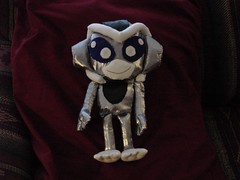 Janet wanted to challenge the girls to take their drawings to a new level. She asked them to create in 3 dimensions. Susan created a plushie of her favorite character from Super Robot Monkey Team Hyper Force Go! Carrie designed and made a beautiful gold dress.
Janet wanted to challenge the girls to take their drawings to a new level. She asked them to create in 3 dimensions. Susan created a plushie of her favorite character from Super Robot Monkey Team Hyper Force Go! Carrie designed and made a beautiful gold dress.
Doing projects together allowed us to experience what barriers were preventing these talented girls from being successful. We encountered executive functioning issues – the inability to make a plan and stick to it. They would become lost in the details losing sight of the larger picture. We also encountered the effects of perseveration on forward progress. The girls would often become fixated on a character or a theme and it would be difficult to move to a new project. We experienced cognitive distortions such as rigid thinking, over-generalization, over-personalization, and other thought patterns that impede positive progress and social integration.
It became clear that by working on projects with our clients allowed us to see, feel, understand, and experience their world in a way that sitting in a room doing ‘talk-therapy’ would never be able to do. Because the girls were interested and invested in the projects they had motivation to solve the issues that arose.
Night of the Living Dead
Carrie was also very interested in Anime Music Videos (AMV). These are fan-made cuts of an anime film making a short music video with the cuts synched to the music. She watched these all the time but had never been able to make one herself. Dan was not (and is still not) an anime fan but he and Carrie compromised on using footage from the original Night Of The Living Dead (now in public domain) set to Marilyn Manson’s cover of Sweet Dreams. Their goal was to make their AMV in one afternoon so that Carrie could experience all the steps of the project end-to-end.
 Over the course of an afternoon they completed the video and uploaded it to YouTube. Carrie loved the finished product and this was Dan’s first experience working as a mentor one-on-one.
Over the course of an afternoon they completed the video and uploaded it to YouTube. Carrie loved the finished product and this was Dan’s first experience working as a mentor one-on-one.
The project was a success. We later realized that the key to this experience was:
• choosing materials easily obtained or already on hand. In the first session, it is important that external obstacles are minimal: you want to see the student’s internal issues.
• being able to finish that first project in one sitting – a small sample sized project. The real product of the session is a working relationship which lasts beyond this one session.
• demanding acceptable quality. It is essential that the student be proud of their product.
The lessons we learned from these very first clients became some of the fundamental principles upon which we built the Autistry programs. From Kent we learned that creating meaningful relationships with ASD individuals takes time and patience. Trust does not come easily as, generally, they are not accustomed to people understanding their world. Susan and Carrie helped us to fully appreciate the importance of breaking out of the talk-therapy box. With them we learned that helping a client discover their strength and develop their talents is the most effective way to support their becoming independent.




 We have come to see that this is a pattern of ritual experienced by many families with an ASD child. The signature is “I get to do this thing I want, when I want, the way I want or I will blow up! And make you [pick all that apply:] embarrassed, scared, afraid the neighbors will call the police, etc.”
We have come to see that this is a pattern of ritual experienced by many families with an ASD child. The signature is “I get to do this thing I want, when I want, the way I want or I will blow up! And make you [pick all that apply:] embarrassed, scared, afraid the neighbors will call the police, etc.” We will not call what we did “calling his bluff” because ASD kids do not bluff. The next night we drew the line. And Ian blew. Dan physically moved Ian back to his room and let him continue to tantrum. Again, Ian was 9 so we were able to physically manage him without damage to us or him. Ian yelled, screamed, and threw things for about 90 minutes until physically exhausted. We allowed him to do one of the alternatives we had offered and he finally went to bed.
We will not call what we did “calling his bluff” because ASD kids do not bluff. The next night we drew the line. And Ian blew. Dan physically moved Ian back to his room and let him continue to tantrum. Again, Ian was 9 so we were able to physically manage him without damage to us or him. Ian yelled, screamed, and threw things for about 90 minutes until physically exhausted. We allowed him to do one of the alternatives we had offered and he finally went to bed. Consistent boundaries mean that once you have defined a boundary, you must not in any way signal that the child can overcome the boundary (overcome you), by tantrum or sheer stubbornness. Additionally, everyone in the child’s life must adhere to the same boundary (We discuss this more in later sections: we find that inconsistent boundaries across different environments and with different adults in a child’s life teaches them to lie and be sneaky).
Consistent boundaries mean that once you have defined a boundary, you must not in any way signal that the child can overcome the boundary (overcome you), by tantrum or sheer stubbornness. Additionally, everyone in the child’s life must adhere to the same boundary (We discuss this more in later sections: we find that inconsistent boundaries across different environments and with different adults in a child’s life teaches them to lie and be sneaky).
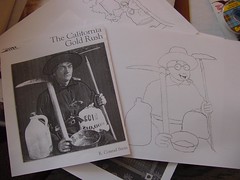
 That evening we informed Ian that he had lost his computer privileges until he could behave himself when in our car in heavy traffic. He promised never to do it again. But we said that promises were not good enough and that he would have to show us he could handle the frustration of traffic. He was VERY unhappy and upset with us. But he thought about it.
That evening we informed Ian that he had lost his computer privileges until he could behave himself when in our car in heavy traffic. He promised never to do it again. But we said that promises were not good enough and that he would have to show us he could handle the frustration of traffic. He was VERY unhappy and upset with us. But he thought about it. That Ian was able to challenge himself to tolerate his traffic frustration encouraged us to have higher long term expectations for him. We realized that for Ian when presented with a desired goal, given defined boundaries and appropriate support he could change negative behaviors.
That Ian was able to challenge himself to tolerate his traffic frustration encouraged us to have higher long term expectations for him. We realized that for Ian when presented with a desired goal, given defined boundaries and appropriate support he could change negative behaviors. Our son is autistic and his autism has driven much that we have done and learned. Ian was born early in 1995 while we were living in Bloomington, Indiana. Dan was a Ph.D. candidate at Indiana University studying Astrophysics. Janet was a librarian at the local public library and was working on her Masters degree in Library and Information Science at IU. Towards the end of the pregnancy Janet’s blood pressure started to increase and she was diagnosed with preeclampsia. As her due date approached her doctors worked to induce a normal delivery. After nearly two weeks Janet’s condition deteriorated to eclampsia and Ian was delivered by emergency c-section. Ian was full term and a very healthy baby at birth.
Our son is autistic and his autism has driven much that we have done and learned. Ian was born early in 1995 while we were living in Bloomington, Indiana. Dan was a Ph.D. candidate at Indiana University studying Astrophysics. Janet was a librarian at the local public library and was working on her Masters degree in Library and Information Science at IU. Towards the end of the pregnancy Janet’s blood pressure started to increase and she was diagnosed with preeclampsia. As her due date approached her doctors worked to induce a normal delivery. After nearly two weeks Janet’s condition deteriorated to eclampsia and Ian was delivered by emergency c-section. Ian was full term and a very healthy baby at birth. But as the months passed he began to miss the usual milestones of speech development. We had one of those “What to Expect…” books and noted with increasing worry and dread each “normal” milestone he missed. He did not babble in a speech-like way in the early months. He was not drawn to noise-making toys nor did he imitate different speech sounds. He seemed totally mystified by games of Peek-a-Boo. But he always smiled. He made eye contact. And he loved to be held. Ian seemed to communicate without words. And though we thought his utter fascination with cupboard door hinges, the pliability of a sheet of paper, or the concentric ripples in a dog’s water dish was a bit eccentric we simply chalked it up to being the son of a scientist. We took comfort in the stories that Einstein didn’t speak until he was 3 years old. Even though Ian never measured up to the What to Expect timelines he nevertheless developed into an attractive, engaging and affectionate child.
But as the months passed he began to miss the usual milestones of speech development. We had one of those “What to Expect…” books and noted with increasing worry and dread each “normal” milestone he missed. He did not babble in a speech-like way in the early months. He was not drawn to noise-making toys nor did he imitate different speech sounds. He seemed totally mystified by games of Peek-a-Boo. But he always smiled. He made eye contact. And he loved to be held. Ian seemed to communicate without words. And though we thought his utter fascination with cupboard door hinges, the pliability of a sheet of paper, or the concentric ripples in a dog’s water dish was a bit eccentric we simply chalked it up to being the son of a scientist. We took comfort in the stories that Einstein didn’t speak until he was 3 years old. Even though Ian never measured up to the What to Expect timelines he nevertheless developed into an attractive, engaging and affectionate child. For financial reasons Dan quit school before finishing his Ph.D. but found that his programming skills were in very high demand back where we grew up in the San Francisco Bay Area. We moved the family to Marin County in 1997. Ian was two and a half. We did not know any pediatricians in the area so Janet somewhat randomly chose the first one found in the health insurance providers list. This doctor happened to specialize in developmental pediatrics and their first appointment, a simple well-baby checkup, stretched into nearly three hours and ended with the doctor solemnly stating: “I think we need to consider the possibility that your son is autistic.”
For financial reasons Dan quit school before finishing his Ph.D. but found that his programming skills were in very high demand back where we grew up in the San Francisco Bay Area. We moved the family to Marin County in 1997. Ian was two and a half. We did not know any pediatricians in the area so Janet somewhat randomly chose the first one found in the health insurance providers list. This doctor happened to specialize in developmental pediatrics and their first appointment, a simple well-baby checkup, stretched into nearly three hours and ended with the doctor solemnly stating: “I think we need to consider the possibility that your son is autistic.”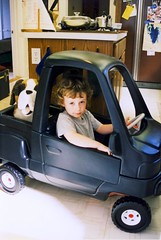
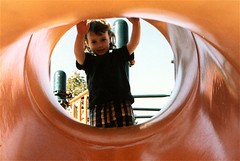
 She considered Ian to be a “low-functioning autistic”. The worst diagnosis they give. Dan remembers that the only literature he could find was that people with that diagnosis had an 80% probability of being institutionalized as adults. At that time there was very little literature to look at and none was particularly encouraging. UCSF had a list of many things they wanted Ian to do with them but we quickly saw that all they were interested in was studying Ian, not treating him. The lack of guidance as to what we should do was very upsetting to us.
She considered Ian to be a “low-functioning autistic”. The worst diagnosis they give. Dan remembers that the only literature he could find was that people with that diagnosis had an 80% probability of being institutionalized as adults. At that time there was very little literature to look at and none was particularly encouraging. UCSF had a list of many things they wanted Ian to do with them but we quickly saw that all they were interested in was studying Ian, not treating him. The lack of guidance as to what we should do was very upsetting to us.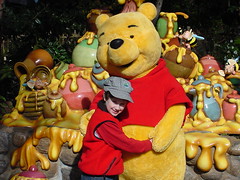 Ian, like most young children, loved Winnie the Pooh. When he first began to talk he would stay up all night reciting long passages from the Disney movies. His lilting sing-song voice was not a good lullaby so Janet was up all night with him. So she too memorized the Winnie-the-Pooh dialogue. One night as Ian recited the well worn lines Janet took the part of Tigger – “The wonderful thing about tiggers, is tiggers are wonderful things…” Ian whipped his head around, looked her right in the eye…and then burst into laughter. She had entered his world. That was the first night he fell asleep before 3am. Janet had found a way to connect with him in that very special world of his imagination.
Ian, like most young children, loved Winnie the Pooh. When he first began to talk he would stay up all night reciting long passages from the Disney movies. His lilting sing-song voice was not a good lullaby so Janet was up all night with him. So she too memorized the Winnie-the-Pooh dialogue. One night as Ian recited the well worn lines Janet took the part of Tigger – “The wonderful thing about tiggers, is tiggers are wonderful things…” Ian whipped his head around, looked her right in the eye…and then burst into laughter. She had entered his world. That was the first night he fell asleep before 3am. Janet had found a way to connect with him in that very special world of his imagination. As the parents of a newly diagnosed autistic child we entered a world where it felt like every week brought a new Thing We Could Do to Cure Our Child. Music! Horses! Computer games! No computer games! Magnets! We looked into all of them. Everyone we knew sent us literature they had found. “Have you tried….?” There was constant guilt that we were not doing enough. Constant frustration when the weekly “cure” turned out to work on ONE child in the entire world. And then friends would keep sending us information about that same cure for the next month. We came to call this: living with the threat of a cure (that you did not take advantage of!).
As the parents of a newly diagnosed autistic child we entered a world where it felt like every week brought a new Thing We Could Do to Cure Our Child. Music! Horses! Computer games! No computer games! Magnets! We looked into all of them. Everyone we knew sent us literature they had found. “Have you tried….?” There was constant guilt that we were not doing enough. Constant frustration when the weekly “cure” turned out to work on ONE child in the entire world. And then friends would keep sending us information about that same cure for the next month. We came to call this: living with the threat of a cure (that you did not take advantage of!). In Ian’s schooling we generally received good service by collaborating with the districts as best we could. We tried wherever possible to provide extra help and materials to support the classroom teachers. And we mostly managed without huge legal battles – that is not to say that there were never heated negotiations. But the outcome was always agreed to be in Ian’s best interest. Ian is currently a senior in high school and will graduate with a certificate of completion with the same group of kids he has been with since fourth grade.
In Ian’s schooling we generally received good service by collaborating with the districts as best we could. We tried wherever possible to provide extra help and materials to support the classroom teachers. And we mostly managed without huge legal battles – that is not to say that there were never heated negotiations. But the outcome was always agreed to be in Ian’s best interest. Ian is currently a senior in high school and will graduate with a certificate of completion with the same group of kids he has been with since fourth grade.
 It’s almost Valentine’s Day and the love is flowing at Autistry. Last Friday,
It’s almost Valentine’s Day and the love is flowing at Autistry. Last Friday, 

 Our School Partnership Program got off to a great start in January. Students from Oak Hill School and Star Academy are coming each week to Autistry to build stuff. And there are some great projects happening: guitars, clocks, bead-work, lathe-work, and much, much more. Our staff works closely with the school staff to provide a creative, inspiring and confidence building experience for each student. As Autistry expands we would like to include more schools in our partnership program.
Our School Partnership Program got off to a great start in January. Students from Oak Hill School and Star Academy are coming each week to Autistry to build stuff. And there are some great projects happening: guitars, clocks, bead-work, lathe-work, and much, much more. Our staff works closely with the school staff to provide a creative, inspiring and confidence building experience for each student. As Autistry expands we would like to include more schools in our partnership program. So I have not written in this blog for some time and I apologize. My intent was to do this more regularly but perhaps monthly is a better goal.
So I have not written in this blog for some time and I apologize. My intent was to do this more regularly but perhaps monthly is a better goal.  Connor has been attending a county program since finishing up high school. This is a program that stresses very little academics and has a lot of down time. We decided to have Connor attend as he needed a place where he would be engaged and around others his age. There was also a very structured transportation element that would facilitate independence in taking the bus. We had only hoped to have Connor attend for a year as we worked to figure out other post high school options. He is now in his second year and really thriving. What has happened is Connor has taken complete ownership for this program. He knows on what days he needs to bring lunch and makes his own without any involvement from us. On the days he goes to Safeway he checks with his dad about what he should purchase. Connor will also buy things that he needs like mouthwash or toothpaste. He monitors this on his own. He gets ready in the morning on his own and is always ready when the taxi arrives. We in fact do not need to be home. He is also taking the bus on his own. He is given money at the beginning of the week and has to budget for the week to cover lunches, bus fare and trips to Safeway. I share this as sometimes as parents we walk away from some programs without considering the long term impact. I have actually never visited this class when in session as I knew I would be looking for something else. Connor is almost 21 and he needs to make his own choices and also be responsible for his activities. We have really stepped back and we are the ones who are also transitioning.
Connor has been attending a county program since finishing up high school. This is a program that stresses very little academics and has a lot of down time. We decided to have Connor attend as he needed a place where he would be engaged and around others his age. There was also a very structured transportation element that would facilitate independence in taking the bus. We had only hoped to have Connor attend for a year as we worked to figure out other post high school options. He is now in his second year and really thriving. What has happened is Connor has taken complete ownership for this program. He knows on what days he needs to bring lunch and makes his own without any involvement from us. On the days he goes to Safeway he checks with his dad about what he should purchase. Connor will also buy things that he needs like mouthwash or toothpaste. He monitors this on his own. He gets ready in the morning on his own and is always ready when the taxi arrives. We in fact do not need to be home. He is also taking the bus on his own. He is given money at the beginning of the week and has to budget for the week to cover lunches, bus fare and trips to Safeway. I share this as sometimes as parents we walk away from some programs without considering the long term impact. I have actually never visited this class when in session as I knew I would be looking for something else. Connor is almost 21 and he needs to make his own choices and also be responsible for his activities. We have really stepped back and we are the ones who are also transitioning.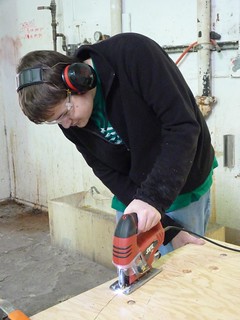 Connor has 3 different part time jobs/internships including the Autistry Model Employment Program. He works hard at these jobs and we are hopeful that this will be a foundation for future employment as he has acquired great skills and understands better the work environment. We await word from the Department of Rehabilitation as we hope to transfer Connor to paying jobs. I will blog about that journey. We still have not accessed GGRC but will be soon.
Connor has 3 different part time jobs/internships including the Autistry Model Employment Program. He works hard at these jobs and we are hopeful that this will be a foundation for future employment as he has acquired great skills and understands better the work environment. We await word from the Department of Rehabilitation as we hope to transfer Connor to paying jobs. I will blog about that journey. We still have not accessed GGRC but will be soon.